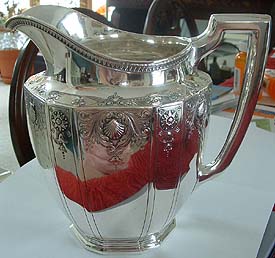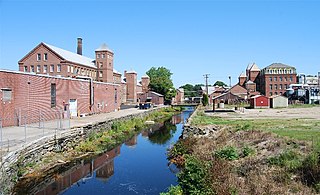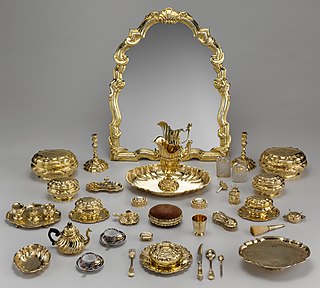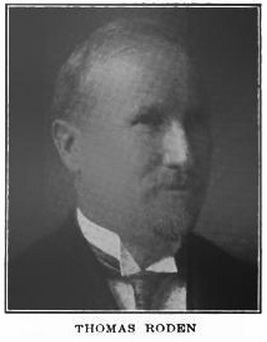Related Research Articles

Wallingford is a town in New Haven County, Connecticut, United States, centrally located between New Haven and Hartford, and Boston and New York City. The population was 44,396 at the 2020 census. The community was named after Wallingford, in England.

Sterling silver is an alloy of silver containing 92.5% by weight of silver and 7.5% by weight of other metals, usually copper. The sterling silver standard has a minimum millesimal fineness of 925.

Meriden is a city in New Haven County, Connecticut, United States, located halfway between the regional cities of New Haven and Hartford. In 2020, the population of the city was 60,850.

Reed & Barton was a prominent American silversmith manufacturer based in the city of Taunton, Massachusetts, operating between 1824 and 2015. Its products include sterling silver and silverplate flatware. The company produced many varieties of britannia and silver products since Henry G. Reed and Charles E. Barton took over the failing works of Isaac Babbitt in Taunton. During the American Civil War, Reed & Barton produced a considerable quantity of weapons for Union Army soldiers and officers.

The Gorham Manufacturing Company is one of the largest American manufacturers of sterling and silverplate and a foundry for bronze sculpture.

Household silver or silverware includes tableware, cutlery, and other household items made of sterling silver, silver gilt, Britannia silver, or Sheffield plate silver. Silver is sometimes bought in sets or combined to form sets, such as a set of silver candlesticks or a silver tea set.

Towle Silversmiths is an American silver manufacturer.

Jens Harald Quistgaard was a Danish sculptor and designer, known principally for his work for the American company Dansk Designs, where he was chief designer from 1954 and for the following three decades.
William Hazen Rogers was an American master silversmith and a pioneer in the silver-plate industry and whose work and name have survived to the present day.

Roden Brothers was a Canadian tableware design and manufacturing company. It was founded on June 1, 1891 in Toronto by Thomas and Frank Roden. In the 1910s the firm became known as Roden Bros. Ltd. and were later taken over by Henry Birks and Sons in 1953. Roden Bros Ltd.'s silver was supplied by the province of British Columbia and with it they produced a wide range of silver holloware and flatware in traditional English styles. The company offered a variety of flatware patterns that included Stratford, Queens, and Louis XV. Goldsmiths Stock Company were their exclusive selling agents from 1900 to 1922. Roden Bros Ltd.'s mark included the word Sterling, followed by 925, an R and a lion passant. In addition to silver hollowware and flatware, Roden Bros. Ltd. produced cut crystal and medals. In 1974 Roden Bros. Ltd. published the book, Rich Cut Glass with Clock House Publications in Peterborough, Ontario, which was a reprint of the 1917 edition published by Roden Bros., Toronto.

Levison Brothers / California Jewelry Co. was active from 1859 to 1935. Founded in 1859, they occupied 629 Washington Street, San Francisco, California by 1863, and by 1871 moved into two floors of their own building at 134 Sutter Street, San Francisco, furnished with machinery, tools, and appliances powered by a 25-horsepower engine.

The Manning, Bowman & Co. (1849-1945) was formed in Meriden, Connecticut, and over the years produced granite iron and pearl agate ware, electro-silver and nickel-plated ware, britannia and planished goods.
The International Silver Company , also known as the ISC, was formed in Meriden, Connecticut as a corporation banding together many existing silver companies in the immediate area and beyond.

The Meriden Britannia Company was formed in 1852 in Meriden, Connecticut, as a manufacturing company focused on producing wares in britannia metal. It became, for a time, the largest silverware company in the world.

Simpson, Hall, Miller & Co. was a cutlery and silver hollowware manufacturer in Wallingford, Connecticut, founded in 1866. By c. 1895, the company operated large factories in Wallingford and Montreal, Canada.
In 1872, the Derby Silver Company began production in Derby, CT. Over the years, the company made bathroom-related items, clocks, tableware and flatware, tea sets, candlesticks, fruit baskets, dishes, and more object types made of silver and silver plate. The Derby Silver Company operated showrooms in New York, Chicago, and San Francisco. As of 1893, the President and Manager of the company was Watson J. Miller. Wesley L. Clark was the Secretary and Treasurer.
William Dean Whiting was an American silversmith and jeweler. He was the founder of the Whiting Manufacturing Company, and "one of the most prominent jewelry manufacturers" in the United States according to the Boston Globe.

The William B. Durgin Company was a noted American sterling silver manufacturer based in Concord, New Hampshire, and one of the largest flatware and hollowware manufacturers in the United States. Over the period 1905-1924 it was merged into the Gorham Manufacturing Company.

Peter Lewis Krider, also known as P.L. Krider, was a noted American silversmith, active in Philadelphia.

John Chandler Moore was a noted American silversmith, active in New York City. He worked exclusively for Tiffany & Co. after 1851 and his son, Edward Chandler Moore, became in charge of designing and manufacturing silverware at Tiffany.
References
- ↑ D.H. Hurd & Co. (1893). "Town and city atlas of the State of Connecticut", (p. 214). Boston. Retrieved October 29, 2016.
- ↑ Beckford, William Hale. (1887). " Leading business men of New Haven", (p. 266). Mercantile Pub. Co.: Boston. Retrieved October 29, 2016.
- 1 2 Stern, Jewel. (2005). Modernism in American silver. Dallas Museum of Art and Yale University Press. Retrieved October 29, 2016.
- ↑ (Undated). "A Guide to the International Silver Company Records, 1853-1921". UCONN university libraries, special collections. Retrieved October 29, 2016.
- 1 2 (March 31, 2016). "R. Wallace & Sons / Wallace Brothers Silver Company / Wallace Silversmiths designs in collections, at auction, and in exhibitions". artdesigncafe.com. Retrieved October 29, 2016.
- ↑ Davis, Charles Henry Stanley (1870). History of Wallingford, Conn., From Its Settlement in 1670 to the Present Time. Wallingford, Conn.: Mount Tom Printing House.
- 1 2 (April 2, 2016). "R. Wallace & Sons / Wallace Silversmiths design catalogues and historical information". artdesigncafe. Retrieved May 21, 2018.
- ↑ "Lifetime Brands to Acquire Assets of Syratech Corporation; Acquisition Furthers Lifetime's Tabletop Strategy by Significantly Expanding Its Presence in Flatware". Business Wire. March 8, 2006. Retrieved 2010-05-25.[ dead link ]